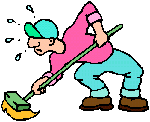Introduction:
All paving should be swept with a stiff brush or broom on a regular basis, to remove dust and detritus that tends to accumulate, especially in sheltered corners, and around drains. This is a perfect job for pesky kids or teenagers!

The paving should be inspected on a quarterly basis, looking for loose, damaged or stained paving, and checking that any jointing material is intact.
Loose Paving
Loose or moving paving may need to be re-bedded, but it is more important to rectify the cause of the movement. Simply packing mortar into a joint and hoping that it will stop the rocking or wobble, is a waste of time - like sticking an elastoplast on a severed artery.
Settlement and/or subsidence of the substrate layers, ie, sub-grade, sub-base and bedding layer, is the most common reason for pavement failure. This settlement may be a result of.......
- incomplete compaction of the substrate layers during construction
- liquefaction of the bedding layer by water ingress
- failure of restraining edges
- loss of jointing material
- application of loads greater than the pavement was designed to carry
Whatever the cause, it needs to be investigated and rectified before replacing or re-bedding the paving units.
Empty Joints
Any missing mortar joints should be re-pointed using the mortar recommended for that type of paving. A guide to pointing or re-pointing flags and slabs can be found on the Pointing page.
With dry-sand jointed pavements, such as some patio flags and block paving, it is essential that the sand joints are kept 'topped-up' - simply brush in extra dry jointing sand as required. However, under normal conditions, jointing sand is expected to seal itself with detritus over a relatively short period of time, around 3 months, and any voids that appear some time after laying may require further investigation.
Common causes for loss of jointing sand include.......
- erosion by exceptional surface water flow
- loss due to vacuum effect of street cleaning equipment
- loss by blast effects of high-powered engines or power-washers
- loss due to ants or other nasticreechas
- loss due to pavement movement
If loss of jointing sand for reasons other than pavement movement/settlement becomes a regular occurrence, it can be countered by the application of a suitable sealant or bonding agent . These sealants and bonding agents bind the sand grains to each other and to the sides of the paving joints and thereby reduce the risk of emptying.
If the loss is due to movement/settlement, the only remedy is for the pavement to be re-constructed, making sure the sub-base and bedding layers are firm, that restraining edges are intact and competent, and that the jointing material is in place.
Stains and Damage
Stain removal and replacing damaged paving are dealt with on separate pages as is Cleaning Paving and how to fix, hopefully, acid and rust stains.
Weed Control
Another simple maintenance job is to treat the paving with a general-purpose weedkiller two or three times a year. We use Glyphosate to treat the drives that we maintain on behalf of our clients, but any good weedkiller, such as 'PathClear' could be used.
A solution of the weedkiller is prepared according to manufacturer's instructions and applied to the paving via a watering can, ensuring every part of the paving is doused with the solution. We treat the paving in early March and again in June. Occasionally we will repeat the treatment in September, if the need arises.
Most paving will require no further maintenance, but the appearance of the work can be enhanced by extremely careful cleaning using a power washer . This is another early spring task, and can readily be undertaken by the householder or contracted out to a paving company or cleaning specialist.
